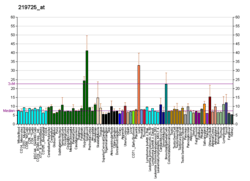TREM2
Triggering receptor expressed on myeloid cells 2 also known as TREM-2 is a protein that in humans is encoded by the TREM2 gene.[5][6][7]
Function
Monocyte/macrophage- and neutrophil-mediated inflammatory responses can be stimulated through a variety of receptors, including G protein-linked 7-transmembrane receptors (e.g., FPR1), Fc receptors, CD14 and Toll-like receptors (e.g., TLR4), and cytokine receptors (e.g., IFNGR1). Engagement of these receptors can also prime myeloid cells to respond to other stimuli. Myeloid cells express receptors belonging to the Immunoglobulin (Ig) superfamily, such as TREM2, or to the C-type lectin superfamily. Depending on their transmembrane and cytoplasmic sequence structure, these receptors have either activating (e.g., KIR2DS1) or inhibitory functions (e.g., KIR2DL1).[7]
Clinical significance
Homozygous mutations in TREM2 are known to cause rare, autosomal recessive forms of dementia with an early onset and presenting with[6] or without[8] bone cysts and fractures.
A rare missense mutation (rs75932628-T) in the gene encoding TREM2, (predicted to result in an R47H substitution), confers a significant risk of Alzheimer's disease. Given the reported antiinflammatory role of TREM2 in the brain, it is suspected of interfering with the brain’s ability to prevent the buildup of plaque.[9][10] TREM2 mutations increase the risk of neurodegenerative conditions such as Alzheimer's disease, amyotrophic lateral sclerosis, and Parkinson's disease. TREM2 interacts with DAP12 in microglia to trigger phagocytosis of amyloid beta peptide and apoptotic neurons without inflammation. Mutations in TREM2 impair the normal proteolytic maturation of the protein which in turn interferes with phagocytosis and may therefore contribute to the pathogenesis of Alzheimer's disease.[11]
Soluble TREM2 has been detected in human cerebrospinal fluid (CSF), where it was found to be elevated in CSF of patients with multiple sclerosis and other inflammatory neurological conditions in comparison to patients without inflammatory neurologic disorders.[12]
References
- 1 2 3 GRCh38: Ensembl release 89: ENSG00000095970 - Ensembl, May 2017
- 1 2 3 GRCm38: Ensembl release 89: ENSMUSG00000023992 - Ensembl, May 2017
- ↑ "Human PubMed Reference:".
- ↑ "Mouse PubMed Reference:".
- ↑ Bouchon A, Dietrich J, Colonna M (Jun 2000). "Cutting edge: inflammatory responses can tgih triggered by TREM-1, a novel receptor expressed on neutrophils and monocytes". J. Immunol. 164 (10): 4991–5. doi:10.4049/jimmunol.164.10.4991. PMID 10799849.
- 1 2 Paloneva J, Manninen T, Christman G, Hovanes K, Mandelin J, Adolfsson R, Bianchin M, Bird T, Miranda R, Salmaggi A, Tranebjaerg L, Konttinen Y, Peltonen L (Aug 2002). "Mutations in two genes encoding different subunits of a receptor signaling complex result in an identical disease phenotype". Am. J. Hum. Genet. 71 (3): 656–62. doi:10.1086/342259. PMC 379202. PMID 12080485.
- 1 2 "Entrez Gene: TREM2 triggering receptor expressed on myeloid cells 2".
- ↑ Guerreiro RJ, Lohmann E, Brás JM, Gibbs JR, Rohrer JD, Gurunlian N, Dursun B, Bilgic B, Hanagasi H, Gurvit H, Emre M, Singleton A, Hardy J (January 2013). "Using exome sequencing to reveal mutations in TREM2 presenting as a frontotemporal dementia-like syndrome without bone involvement". JAMA Neurol. 70 (1): 78–84. doi:10.1001/jamaneurol.2013.579. PMC 4001789. PMID 23318515.
- ↑ Hickman SE, El Khoury J (2014). "TREM2 and the neuroimmunology of Alzheimer's disease". Biochem. Pharmacol. 88 (4): 495–8. doi:10.1016/j.bcp.2013.11.021. PMC 3972304. PMID 24355566.
- ↑ Kolata G (14 November 2012). "Alzheimer's Tied to Mutation Harming Immune Response". New York Times. Retrieved 15 November 2012.
- ↑ Lue LF, Schmitz C, Walker DG (2014). "What happens to microglial TREM2 in Alzheimer's disease: Immunoregulatory turned into immunopathogenic?". Neuroscience. 302: 138–50. doi:10.1016/j.neuroscience.2014.09.050. PMID 25281879.
- ↑ Piccio L, Buonsanti C, Cella M, Tassi I, Schmidt RE, Fenoglio C, Rinker J, Naismith RT, Panina-Bordignon P, Passini N, Galimberti D, Scarpini E, Colonna M, Cross AH (2008). "Identification of soluble TREM-2 in the cerebrospinal fluid and its association with multiple sclerosis and CNS inflammation". Brain. 131 (Pt 11): 3081–91. doi:10.1093/brain/awn217. PMC 2577803. PMID 18790823.
Further reading
- Del Bono N, Dente FL, Del Bono L (2008). "Identification of a novel soluble TREM-2 protein in the cerebrospinal fluid in association with central nervous system inflammation". Brain. 131: 3081–3091. doi:10.1093/brain/awn217. PMC 2577803. PMID 18790823.
- Allcock RJ, Barrow AD, Forbes S, Beck S, Trowsdale J (2003). "The human TREM gene cluster at 6p21.1 encodes both activating and inhibitory single IgV domain receptors and includes NKp44". Eur. J. Immunol. 33 (2): 567–77. doi:10.1002/immu.200310033. PMID 12645956.
- Soragna D, Papi L, Ratti MT, Sestini R, Tupler R, Montalbetti L (2003). "An Italian family affected by Nasu-Hakola disease with a novel genetic mutation in the TREM2 gene". J. Neurol. Neurosurg. Psychiatry. 74 (6): 825–6. doi:10.1136/jnnp.74.6.825-a. PMC 1738498. PMID 12754369.
- Cella M, Buonsanti C, Strader C, Kondo T, Salmaggi A, Colonna M (2003). "Impaired differentiation of osteoclasts in TREM-2-deficient individuals". J. Exp. Med. 198 (4): 645–51. doi:10.1084/jem.20022220. PMC 2194167. PMID 12913093.
- Paloneva J, Mandelin J, Kiialainen A, Bohling T, Prudlo J, Hakola P, Haltia M, Konttinen YT, Peltonen L (2003). "DAP12/TREM2 deficiency results in impaired osteoclast differentiation and osteoporotic features". J. Exp. Med. 198 (4): 669–75. doi:10.1084/jem.20030027. PMC 2194176. PMID 12925681.
- Montalbetti L, Ratti MT, Greco B, Aprile C, Moglia A, Soragna D (2005). "Neuropsychological tests and functional nuclear neuroimaging provide evidence of subclinical impairment in Nasu-Hakola disease heterozygotes". Funct. Neurol. 20 (2): 71–5. PMID 15966270.
- Bianchin MM, Lima JE, Natel J, Sakamoto AC (2006). "The genetic causes of basal ganglia calcification, dementia, and bone cysts: DAP12 and TREM2". Neurology. 66 (4): 615–6, author reply 615–6. doi:10.1212/01.wnl.0000216105.11788.0f. PMID 16505336.




